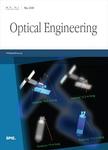版权所有:内蒙古大学图书馆 技术提供:维普资讯• 智图
内蒙古自治区呼和浩特市赛罕区大学西街235号 邮编: 010021

作者机构:Birla Inst Technol Ranchi Jharkhand India
出 版 物:《OPTICAL ENGINEERING》 (光学工程)
年 卷 期:2020年第59卷第3期
页 面:035106-035106页
核心收录:
学科分类:08[工学] 080401[工学-精密仪器及机械] 0804[工学-仪器科学与技术] 081102[工学-检测技术与自动化装置] 0811[工学-控制科学与工程] 0702[理学-物理学]
基 金:University Grant Commission (Ministry of HRD) [F.15-9(JUNE)/2015(NET)]
主 题:visible light communication multiple-input multiple-output lens ray trajectories
摘 要:We have proposed a concave-convex lens for the multiple-input multiple-output (MIMO) visible light communication (VLC) system, which provides more received power than conventional lenses. Ray trajectories using a hemispherical lens, compound parabolic concentrator (CPC), dielectric totally internally reflecting concentrator, and the proposed lens have been simulated in COMSOL software, and it has been shown that the proposed lens provides better convergence at the exit aperture. Also, the images of individual light-emitting diodes (LEDs) are distinguishable, and hence it can support a higher diversity order for the MIMO system. It has been found that our designed lens provides 1.081 times more received power than the hemispherical lens. We have investigated that the average received power using a concave-convex lens is 2.3593 and 1.3737 times more than the received power through bare (uniform refractive index) CPC and gradient-index-based CPC lenses, respectively. We have compared the channel gain using concave-convex and hemispherical lenses considering different values of incidence and half power semiangle of LED. The concave-convex lens has more gain and better volume efficiency;therefore, it can be considered as an appropriate choice for a compact receiver system in an MIMO-VLC system. (C) 2020 Society of Photo-Optical Instrumentation Engineers (SPIE)